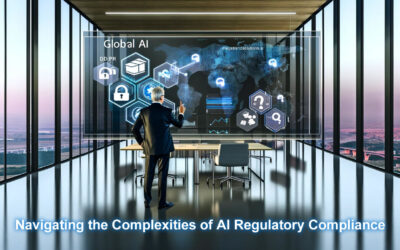In the rapidly evolving digital landscape, artificial intelligence (AI) presents both a significant opportunity and a potential threat to businesses. This article delves into the potential benefits of AI, as well as the challenges it poses, with recent studies and expert analyses suggesting that as many as 50% of businesses could face serious challenges due to AI advancements. It also outlines strategic approaches businesses can adopt to mitigate these risks and harness AI’s potential effectively.
The Disruption Brought by AI
AI’s unparalleled ability to process and analyse large volumes of data at lightning speed is a game-changer. This transformative capability is not just automating complex processes and enhancing decision-making but also inspiring innovative product offerings. However, this rapid integration of AI can also be disruptive. Businesses that fail to adapt to AI technologies risk falling behind their competitors, losing market share, and even facing obsolescence.
- Job Displacement: AI technologies such as machine learning, robotics, and natural language processing are automating tasks that were traditionally performed by humans. This shift can lead to significant job displacement in sectors like manufacturing, customer service, and administrative support. Companies that rely heavily on human labour for these functions are particularly at risk.
- Increased Competition: AI lowers barriers to entry in many industries by making powerful tools accessible to startups and smaller companies. This democratisation of technology intensifies competition and puts additional pressure on established businesses to innovate more quickly and efficiently.
- Cybersecurity Risks: As businesses integrate more AI tools into their operations, they also increase their vulnerability to AI-driven cyber-attacks. These attacks can be more sophisticated and harder to detect than traditional methods, underscoring the need for robust security measures and careful planning.
- Ethical and Regulatory Challenges: The deployment of AI can raise ethical questions and lead to regulatory scrutiny. Issues such as data privacy, surveillance, and bias in AI algorithms must be addressed, potentially diverting focus and resources from other strategic areas.
Strategies to Mitigate AI Threats
Understanding the threats AI poses is only half the battle. Businesses must proactively develop strategies to mitigate these risks while leveraging AI’s potential for growth and innovation. Here are key strategies that can guide businesses through this transformative era:
- Invest in Employee Retraining and Upskilling: One effective response to the threat of job displacement is investing in the current workforce. By retraining employees to work alongside AI technologies, businesses can enhance their human capital and reduce the negative impact of automation.
- Adopt a Phased AI Integration Approach: Instead of overhauling systems overnight, businesses should adopt a gradual approach to integrate AI. This strategy allows for the assessment of impacts on various aspects of operations and the management of risks in a controlled manner.
- Strengthen Cybersecurity Frameworks: To counter the increased risk of sophisticated cyber-attacks, businesses need to strengthen their cybersecurity frameworks. Investing in AI-driven security solutions can provide businesses with the tools needed to protect themselves from emerging threats.
- Focus on Ethical AI Use: Building AI systems that are ethical and comply with existing and anticipated regulations is crucial. Businesses should establish clear guidelines on data usage, privacy, and bias mitigation to build trust among consumers and regulators.
- Innovate Responsively: Businesses should leverage AI not just for efficiency but also to drive innovation. This involves using AI to develop new products and services that meet evolving customer needs and to enter markets that were previously inaccessible.
- Collaborate and Form Partnerships: Given the complexity and resource requirements of AI implementations, forming partnerships can be beneficial. Collaborations with tech firms, startups, and educational institutions can provide businesses access to expertise, cutting-edge technology, and innovation hubs.
Conclusion
AI’s double-edged sword—its potential to disrupt and propel businesses—cannot be ignored. By understanding the specific threats AI poses and implementing strategic measures, businesses can not only shield themselves from potential downsides but also position themselves to capitalise on the many opportunities AI brings. As we move forward, the focus should be on creating a resilient, adaptable business model that embraces AI with a clear vision and a firm grasp of its implications. This approach will enable businesses to thrive in a future where AI is ubiquitous across all sectors of the economy.
Ready to ensure your business not only survives but thrives in the AI era? Contact us today for a no-obligation, 30-minute consultation. Our experts are on hand to help you navigate the complexities of AI integration and transform potential threats into growth opportunities. Don’t wait for the future to define your path—shape it with us.





